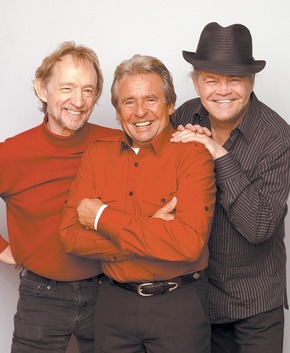The Monkees reunite at the Chumash Casino
 After finishing the pilot for “The Monkees” TV show, Davy Jones and Micky Dolenz were driving home to their rented house when they heard a familiar song on the radio.
After finishing the pilot for “The Monkees” TV show, Davy Jones and Micky Dolenz were driving home to their rented house when they heard a familiar song on the radio.
“Last Train to Clarksville,” a happy-sounding pop song secretly about the Vietnam war, had been recorded by The Monkees for the pilot. But before the show even aired, it was sent to radio stations across the country.
“We had never thought about it going on the radio,” Jones said. “We were making it for a television show. And all of the sudden it’s on the radio, and all of the sudden it’s No. 1 for six weeks.”
It was a curious beginning for what was designed to be a pretend band. But 45 years later, The Monkees are still singing “Last Train to Clarksville,” along with several other hits that proved they were for real.
Their reunion tour will stop at the Chumash Casino next Thursday.
While the TV show made the Monkees both TV stars and recording stars — they outsold both the Beatles and the Rolling Stones combined in 1967 — the four members were entertainers before the show, which debuted in 1966. Mike Nesmith and Peter Tork were both folk singers. Dolenz had been a child actor in the TV show “Circus Boy.” And despite a short stint as a jockey apprentice, Jones, who grew up in the English city of Manchester, had a theater background, most notably appearing as the Artful Dodger in the Broadway play “Oliver!”
It was with that production that he appeared on “The Ed Sullivan Show” in 1964 — on the same episode that featured the Beatles’ first Sullivan appearance. While a handful of kids waited outside for his autograph, streets outside the theatre were barricaded for the throng of crazed Beatles fans.
“Soon after that — I was signed to Columbia Pictures at the time — I said, ‘I want to start recording because I think this is a great way to meet girls,’ ” he said.
It was actually a Beatles film — “A Hard Day’s Night” — that inspired the concept for a silly TV show about an unknown band that performed Beatlesque tunes. While Jones had auditioned for shows like “Batman,” “F-Troop” and “Hogan’s Heroes” to no avail, Columbia decided to build “The Monkees” around him, holding auditions for the three other Monkees.
After rejecting people like
Stephen Stills and Harry Nilsson, the quartet was chosen. Jones and Dolenz had more acting skills, while Nesmith and Tork had more music skills. Still, they were quick studies. And they were aided with a stable of great songwriters, which included Nilsson, Neil Diamond and Carole King.
Each week, the show’s Vaudeville-style humor was paired with a couple of songs, including “Daydream Believer,” “Pleasant Valley Sunday,” and “(I’m Not Your) Steppin’ Stone.”
Yet, even though they were a new act created by the studio, The Monkees quickly demanded more control over their music. So their third album, “Headquarters,” featured mostly songs written by the band, who also demanded to play their own instruments.
“You listen to ‘Headquarters,’ and it sounds raw,” Jones said. “It was fun. It didn’t sell as many — it only sold a million and a half. The rest of them sold three and five million. That was because they didn’t get behind it. They didn’t support it.”
The show lasted only two seasons. And “Head,” a psychedelic movie starring The Monkees, was a commercial failure, seemingly signaling the end of the band’s short run. But the TV show lived on in reruns. Then in the ’80s, MTV hosted a “Monkees” marathon, allowing the show to reach a new generation and sparking a successful reunion tour.
The Monkees would tour again in the late ’90s — selling out two shows at London’s Wembley Stadium. But Nesmith would soon part ways.
By then a successful businessman and producer, Nesmith didn’t need the money, having inherited more than $20 million in 1980 from his mother, who invented Liquid Paper. Still, Jones said, Nesmith was never that committed to The Monkees.
“We’re a better show — we’re a better act—with him not being there,” Jones said. “I wish him all the best in everything he does. But he was never a part of The Monkees. Visually, yes. But not in the heart.”
At various times the different Monkees have quarreled. As recently as 2005, Jones told The Bergen County (N. J.) Record, “There’s absolutely no way on earth that I would ever work with them together or individually ever, ever, ever again.”
But today he’s singing a different tune. In fact, he’s singing many tunes — all with those guys he vowed to never ever, ever perform with again.
“Micky and Peter have come to another place in their lives, which is very attractive to me,” Jones said. “That’s why I’m working with them. I love to be on stage on my own, showing off and telling my stupid jokes and enjoying my own solo career. But they have changed. Or maybe it’s me that’s changed and realized that I’m viewing this from the wrong angle.”
 Follow us
Follow us Join us
Join us


